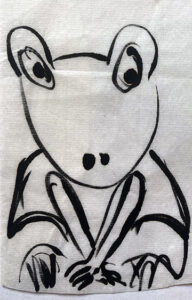by way of introduction
In frog physics, I explore going from recognizing sensation to being cognizant of the meaning of something that is purely observed. What is ‘awareness’? What is ‘consciousness’? Scientists working from a behavioral standpoint may drop ‘consciousness’ as a concept all together from the lexicon of science. That is to say, we may be able to describe things without reference to consciousness at all. But at the same time, one does create a world out of what one can sense. A dispute arises: does one sense a real world? Is a world that is ‘sensed’ simply an example of a created world, created in the process of sensation? Frogs cannot see something that is not moving. With the two parameters we choose here, vision and hunger, we may be able to describe things without reference to consciousness at al. A frog in a short story creates its known world. frog physics is a simplification of the bug detection mechanism of frogs; four types of ganglion cells (a moving-edge detector, a nest-convexity detector, a net-dimming detector and a sustained-contract cell) that work together to inform the brain of visual patterns being viewed. With these four types of pattern detectors, one can describe a perfectly good world. Through art, I am relating the world to me, to my sensations. I am the frog.
frog physics was published in the International Synergy Journal, Volume 7/8, in 1989. Copyright by INTERNATIONAL SYNERGY

